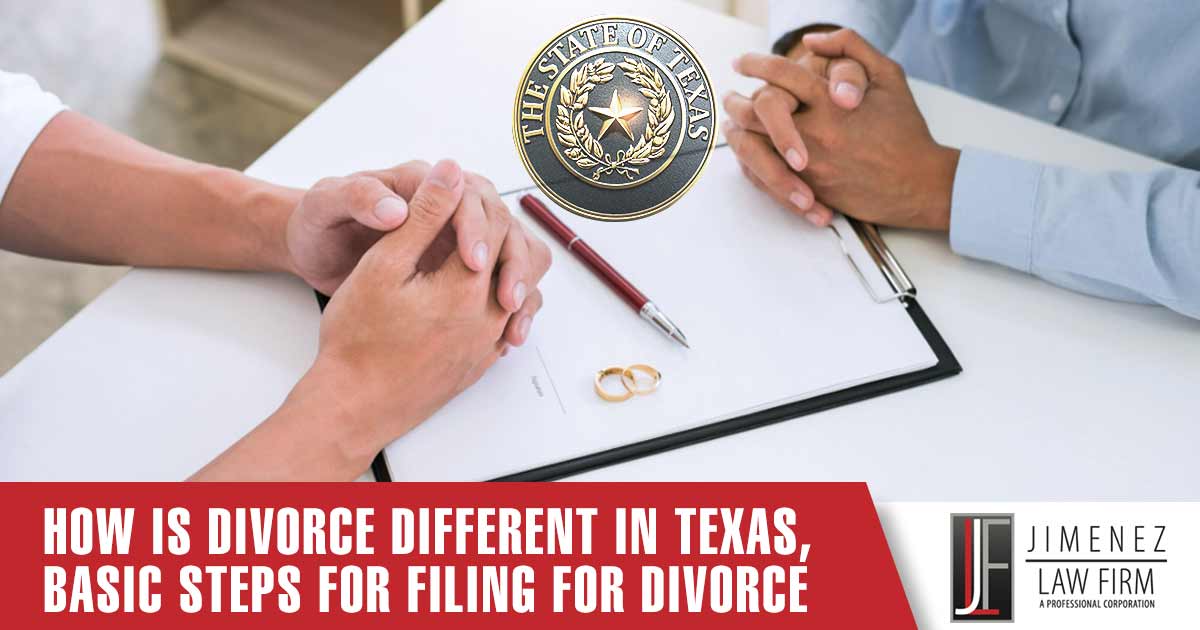Filing for divorce is a big step in your life. This can be true even if it’s a necessary divorce or an uncontested divorce. No matter what type of divorce you’re facing, getting a divorce in Texas has its challenges. Thankfully, an experienced family law attorney can help you through the Texas divorce process and the divorce proceedings. The Jimenez Law Firm is here to guide you through the basic steps for filing for divorce in Texas and ensure your rights are protected.
The Primary 6 Steps of the Texas Divorce Process
When it comes down to it, your divorce attorney will help you through the steps of divorce. Today, we’ll also cover these basic steps and what you can expect along the way.
Step 1: Grounds for Divorce
To start the process of getting divorced, you first need to decide on the grounds for divorce. This means you’ll need to provide justification to the court for ending the marriage. The grounds for divorce will be listed in your divorce papers. Texas law states that the party filing for divorce must select and prove at least one of the following grounds for divorce:
- In supportability, also known as a no-fault divorce
- Adultery
- Cruelty
- Abandonment
- Separation
- Felony Criminal Conviction
- Confinement in a Mental Hospital
While in supportability is a no-fault divorce option, the other six grounds are for a fault-based divorce. No-fault versus fault divorces can impact any spousal support or spousal maintenance (often known as alimony) as well as the division of assets, including property division. A qualified divorce lawyer can provide more insight and legal advice as to what they recommend for your divorce case.
Step 2: Filing the Petition for Divorce
Once you’ve decided on the grounds for your divorce, the next step is to fill out the original petition for divorce, also known as the petition for the dissolution of the marriage. This divorce petition refers to the spouse filing for divorce as the petitioner while referring to the other spouse as the respondent. This petition is what formally starts your divorce case. In addition, to file for divorce in Texas, either the petitioner or the respondent must:
- Live in Texas for a period of at least 6 months prior to filing for divorce
- File in the county that either the petitioner or respondent has resided in for at least 90 days
Family law matters, such as divorce, are typically heard in Texas state district courts. Most divorce cases are filed through the office of the district clerk. The original petition along with copies and the filing fee are delivered to the district clerk’s office in the applicable county. The filing fee varies from county to county.
Step 3: Notifying Your Spouse
After filing your Texas divorce forms, you must give your spouse legal notice. This means that you must serve your spouse with one of these methods:
- Publication or posting
- Hire a process server
- Your spouse signs a waiver of citation
The easiest option is to provide notice through a waiver that waives their right to be formally served. However, this waiver is only valid if signed after you file the original petition. If your spouse is not willing to sign the waiver, then you’ll need to select one of the other two options. Typically, the next step is to hire an authorized third party to serve the divorce papers such as a process server or the Sheriff. Publication or posting is generally a last resort for those individuals who are unable to locate their spouse.
Step 4: Answer and Counterpetition
After your spouse has been served with the divorce papers, it is their move. They have twenty days from when they are served to file an answer. After they file an answer, they are entitled to attend all court hearings throughout the divorce proceedings. At this time, they may also file a counterpetition. The counterpetition states their grounds for filing for divorce and also their requests of the court.
Step 5: Waiting
Texas requires that the parties go through a 60-day waiting period. However, there is an exception in cases of family violence or domestic violence. This waiting period allows both parties to have a cooling-off period and an opportunity to reconcile. It also provides an opportunity for the parties to reach an agreement regarding the divorce terms. If the parties can reach an agreement, then they can proceed with an uncontested divorce. Uncontested divorces keep costs low and can go through an online divorce.
Matters that need to be agreed on include:
- Child Custody
- Child Support
- Visitation for the children
- Division of marital assets
If there are issues reaching an agreement, then it is considered a contested divorce. The court will then make the decisions for both parties. The court may also recommend divorce mediation. In this situation, a neutral third party known as a mediator will try to help you and your spouse reach an agreement.
Step 6: The Divorce Decree
If both parties are still unable to reach an agreement, then the issues are presented to a judge during a final hearing. This may be done with either a bench trial, which means only a judge, or with a jury trial. If you were able to reach an agreement, then the final hearing is generally simple and consists of only a few questions before the judge approves the agreement.
When the final hearing is complete, you’ll receive your final decree of divorce. The divorce decree provides the details for the child support and child custody orders, any spousal support or maintenance, and the division of all community property and any debt.
Once both parties sign and file the divorce decree, they’re considered to be divorced.
Finding Legal Assistance for Your Divorce
While some people go through the divorce process on their own, it’s always recommended you hire a qualified divorce attorney. Not only will they help keep the divorce proceedings on track and in compliance with the court, but they’ll also look out for your best interests. They know the Texas divorce laws inside and out and are an incredible asset during this difficult time.


